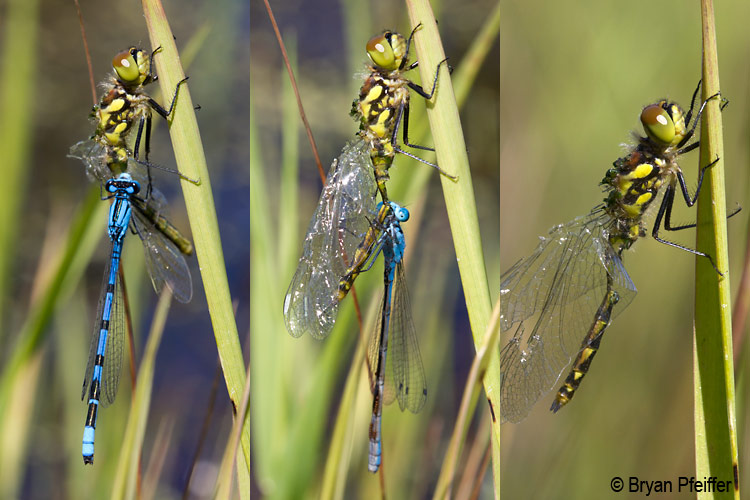DSA Update No. 5: Destination North
ONWARD to the Canadian Shield – the vast region of exposed precambrian rock on which reside infinite lakes, bogs sprinkled with orchids, coniferous woods, and, of course, lots of flying things. We’ve wrapped up the formal gathering of the Dragonfly Society of the Americas. This journey north is the “post-trip meeting” for a smaller group of us. We’ll all be “meeting” outside with insect nets and cameras.
My update from the field yesterday was a damselfly killing and eating (alive) a portion of a dragonfly many times its own size. That’s an Enallagma annexum (Northern Bluet) munching on the abdomen of a Sympetrum danae (Black Meadowhawk). This is a rare event. Turnabout actually, because we are far more likely to encounter dragonflies eating damselflies. The mangled wings are really what will kill him. So here’s a quiz: How did this happen? Submit your wisdom in the comments section below. I’ll post an answer, well, whenever I get back online.
Added July 18, 2013: I’m back from the Canadian Shield (more on that later) to find wise wildlife watchers amoung you. Yep, that Black Meadowhawk (black and yellow in this case) was most likely overtaken in the act of hardening up. When a dragonfly or damselfly first emerges from its larval skin (we call the skin an exuviae when left behind), it is soft, squishy, and vulnerable (those newly emerged adults we call “tenerals”). That’s when the birds get ’em. Yummy! In a matter of hours, they begin to harden and go about life as a full adult doing what mature dragonflies do, which is mostly flying around, killing things, and having sex.
In this case, I suspect the bluet didn’t actually mangle the wings of this meadowhawk. It’s more likely that something else did, perhaps an inopportune gust of wind or something walking by. Once those wings couldn’t function, this was for all intents a dead meadowhawk emerging – easy prey for the Northern Bluet that came along for a feast, a bit too close to where it really hurts (see April’s comment below).


Hi Pete:
Two members of the same insect order, with the suborder Zygoptera=Damselflies and the suborder Anisoptera=Dragonflies.
Dragons: big (with a few exceptions), robust, holding wings flat when perched.
Damsels: tiny, elegant, dainty (like those little bluets on the pond), and holding wings folded (with just a few exceptions) over the body when at rest.
Brian, Where do you parse out the difference between dragons and damsels?
Ouch! 🙂
Noting the approximate anatomical area of munching, (although I suppose that gender is undetermined) what WOULD Freud say about this? They are, after all, somewhat related.
A car accident?
The Meadow Hawk had probably just emerged and its wings were not developed.
I learn something new every day! We could use a few mosquito eaters back home.
Patti
I imagine the bluet damselfly came upon the newly emerged meadowhawk before its exoskeleton had hardened and its wings expanded and hardened. It’s all about timing.
Wonderful. Looks like the victim’s wings were not yet dried.
The meadowhawk wings are still so shiny I suspect it is a recent molt from nymph stage. Something calamitous happened as it molted and it’s wings and they are deformed,leaving it helpless and unable to fly. Lucky bluet!
I don’t have an answer to the question, but I have to comment on your trip.
What a journey you are on. I am enjoying all the pictures and conversation you
bestow. Have fun along w/ the joy of it all!!!
Colleen